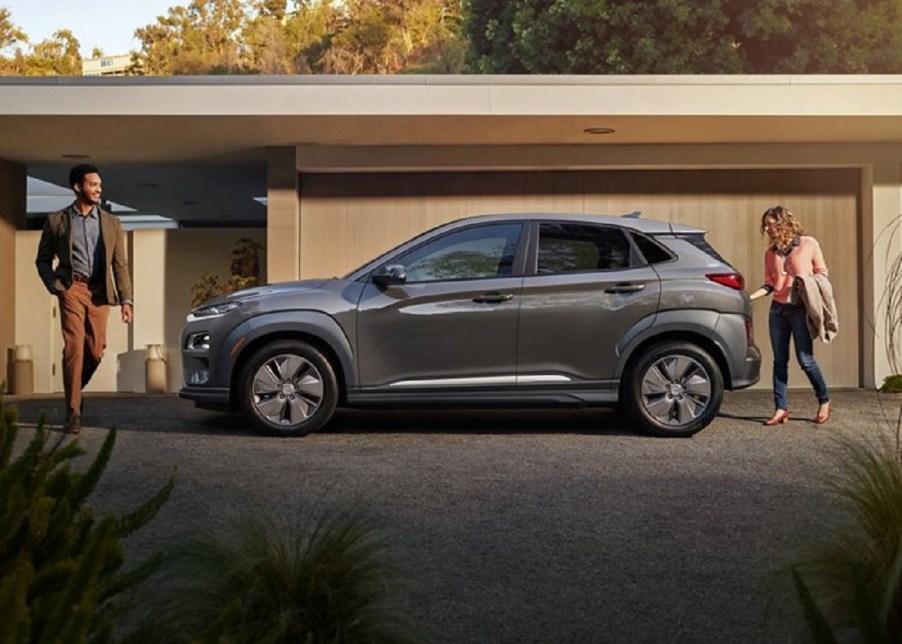
The 2021 Hyundai Kona Electric Upsets the 2021 Tesla Model X
The 2021 Hyundai Kona Electric and 2021 Tesla Model X are two electric SUVs with good overall ratings. One might assume that the more-experienced Tesla Model X would outshine the Kona Electric, but it turns out that the relative newcomer to the electric SUV category already knows what it’s doing. Let’s look at what these two electric vehicles are doing right – and why the Kona Electric is better.

The range is decent in the 2021 Hyundai Kona Electric and 2021 Tesla Model X
Range anxiety is a thing which plagues those who are considering purchasing an electric vehicle, but are afraid of not being able to drive very far with it. Some people cite long charging times as a problem. Those people might want to be able to charge their electric vehicles at home while they sleep, which eans they’ll need an EV that can get them where they need to go – and back – each day.
The 2021 Hyundai Kona Electric gets 260 miles of cruising range, while the 2021 Tesla Model X gets 295 miles. Tesla has access to Tesla’s Supercharger network, while as of now, the Kona has to rely on secondary chargers. This may change soon though, as Elon Musk recently announced that non-Tesla drivers will soon be able to use Tesla Superchargers.
The 2021 Tesla’s road test score is higher
Consumer Reports gives the 2021 Tesla Model X a 5/5 for its acceleration. It can reach 0 to 60 in a super fast 4.9 seconds. Its transmission scores a perfect 5/5. Routine and emergency handling both receive a very good 4/5. The Tesla Model X’s max avoidance speed is 54 mph.
Braking is fantastic in the X. It scores a 5/5 and can brake from 60 mph on wet pavement in 127 feet and dry pavement in 135 feet. The X’s headlights score a not-great 2/5.
The 2021 Hyundai Kona Electric’s scores are somewhat similar, though slightly different. Consumer Reports gives the 2021 Hyundai Kona Electric a 4/5 for its acceleration. It can reach 0 to 60 in 6.6 seconds.
Its transmission scores a perfect 5/5. Routine handling gets a very good 4/5, but its emergency handling only receives a 3/5. The Hyundai Kona Electric’s max avoidance speed is 54 mph.
Braking is very good in the Kona Electric. It scores a 4/5 and can brake from 60 mph on wet pavement in 135 feet and dry pavement in 145 feet.
The Kona Electric’s headlights score a pretty terrible 1/5.
Their safety equipment is different but plentiful
The 2021 Hyundai Kona Electric comes standard with almost all of this safety equipment. Standard in the Kona Electric is forward collision warning, automatic emergency braking for the city, lane departure warning, lane-keeping assist, and blind-spot warning. It also has rear cross-traffic warning, a rearview camera, anti-lock brakes, traction and stability control, and daytime running lights. Pedestrian detection is optional in the Kona Electric, and emergency braking for the highway isn’t available.
Neither the IIHS nor the NHTSA have crash-tested the 2021 Hyundai Kona Electric.
The 2021 Tesla Model X comes standard with forward collision warning, automatic emergency braking, pedestrian detection, lane keeping assist and lane departure warning. It also has a rear camera, anti lock brakes, traction and stability control, and daytime running lights. There’s no option to get blind spot warning or rear cross traffic warning.
The IIHS hasn’t crash-tested the 2021 Tesla Model X, but the NHTSA has. It gives the 2021 Tesla Model X all good crash test-ratings.
If the Consumer Reports ratings don’t hel pyou decide between these two electric SUVs, you may be interested to know that Tesla recently performed a Full Self-Driving software update, meaning more Teslas will be able to operate autonomously. This may be something that you want to consider, as those driving with Full Self-Driving are essentially testing out the software for the company. With this in mind, combined with Consumer Reports’ ratings, and it’s easy to see why the 2021 Hyundai Kona Electric is a better pick.


